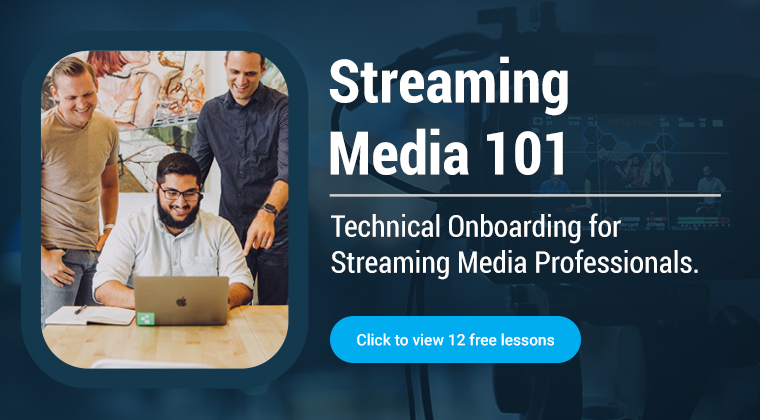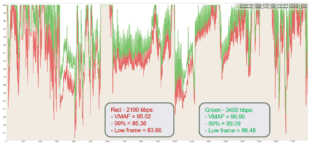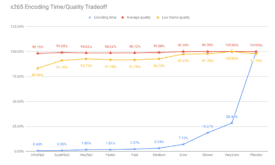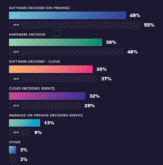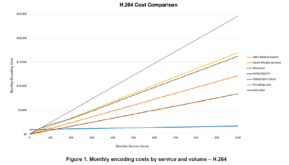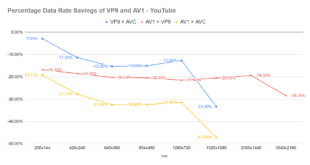Companies attempting to formulate the ideal encoding ladder for specific videos or classes of content should incorporate both the harmonic mean VMAF score for overall quality and the percentile score to minimize transient quality issues. I’ve spent much of the last few weeks benchmarking H.264 and HEVC cloud-based per-title encoding capabilities like those available from AWS Elemental, Microsoft Azure, Brightcove, …
Read More »Choosing an x265 Preset: an ROI Analysis
This post presents a return on investment view of choosing an x265 preset that delivers the optimal blend of encoding cost and storage and bandwidth savings. The first chart, x265 Encoding Time/Quality Tradeoff, is from a lesson in my course Streaming Media 101: Technical Onboarding for Streaming Media Professionals. Given the bandwidth and storage savings that higher-quality x265 presets deliver, …
Read More »Buyers Guide: Choosing a Software-Based Streaming Encoder for VOD
This entry-level article describes what an encoder is and how to choose one and focuses on VOD, not live. It was derived from a lesson in my Streaming Media 101 course, which teaches you the skills and techniques to succeed in a streaming media-related role. Click here for more details about the course. This article walks newbies through what an …
Read More »Choosing the Resolution for Lower Rungs on Your Encoding Ladder
Your encoding ladder should include lower resolution rungs even if higher resolution rungs deliver better quality. This blog explains why. Several lessons in the online course Streaming Media 101: Technical Onboarding for Streaming Media Professionals focus on creating and configuring encoding ladders, including the Convex Hull technique discussed below. With advanced codecs like AV1 and HEVC, however, this analysis leads …
Read More »Seeking Input: Which Low-Res Rungs are Essential to an Encoding Ladder
Note: I received some very useful responses to this blog that are summarized in a post entitled, Choosing the Resolution for Lower Rungs on Your Encoding Ladder. I could use some input from practitioners out there about which lower resolution rungs are essential to an encoding ladder. By way of background, I’m preparing a per-title encoding comparison. To derive the …
Read More »Crunch Video Optimization Now Available on Oracle Cloud Marketplace
I’ve been a fan of video optimization technologies for a while now, and consider optimization simpler, cheaper, and potentially just as effective as adding a new codec like HEVC or VP9. I’m pleased to see that the Crunch Mediaworks Video Enhancement Solutions App is now available on the Oracle Cloud Marketplace. I reviewed Crunch‘s technology back in 2019 for video …
Read More »Cloud Encoding Pricing Comparison Reveals Dramatic Cost Differences – Are You Overpaying?
This whitepaper, sponsored by Dolby/Hybrik, tracks cloud encoding pricing for H.264 and HEVC output and reveals dramatic price differences among popular services. I’ve just completed a whitepaper sponsored by Dolby/Hybrik to compare pricing for multiples of one hour of H.264 and HEVC encoding using the recommended encoding ladders in the Apple HLS Authoring Specifications. You can download the whitepaper here. …
Read More »Which Codec Does YouTube Use, Part III
This article analyzes the codecs used by YouTube for 4K videos with millions of views, and the savings that AV1 and VP9 deliver over YouTube’s full encoding ladder. This is the third in a series of articles written about which codecs YouTube uses. The first covers which codecs YouTube uses for high-volume 1080p videos. The second covers the codecs used …
Read More »Formulate the Optimal Encoding Ladder with VMAF
This post describes how to formulate the optimal encoding ladder with VMAF. This analysis is excerpted from a lesson in the online course Streaming Media 101: Technical Onboarding for Streaming Media Professionals. I received the following question from a reader; it’s got such general applicability that I thought I would share my response. Question: We’re currently reviewing our ABR ladder …
Read More »Which Codecs Does YouTube Use?
Author’s Note (March 15, 2022): A colleague recently advised me that YouTube was now encoding all videos into VP9 format. A quick check revealed that he was correct; literally every video that I checked, including some uploaded back in 2010, was encoded into VP9 as well as H.264. What’s interesting is that many low-volume videos, like this one with 118 …
Read More » Streaming Learning Center Where Streaming Professionals Learn to Excel
Streaming Learning Center Where Streaming Professionals Learn to Excel

